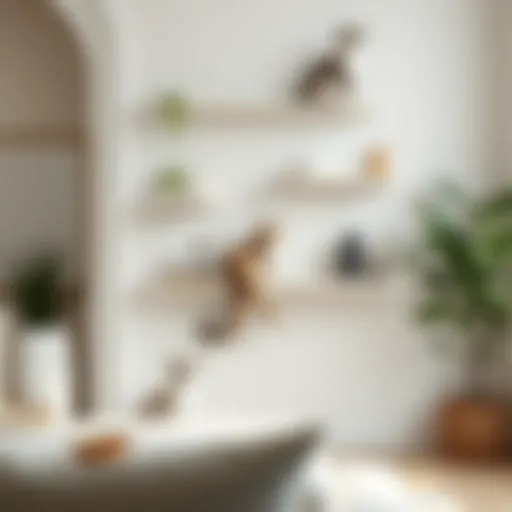Stylish Metal Patio Tables with Wood-Like Appeal
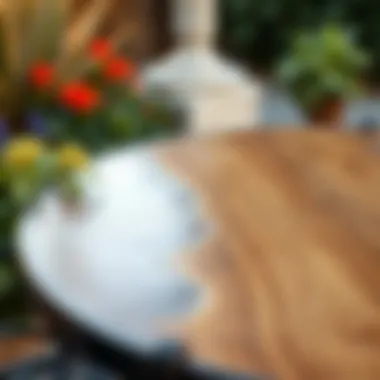
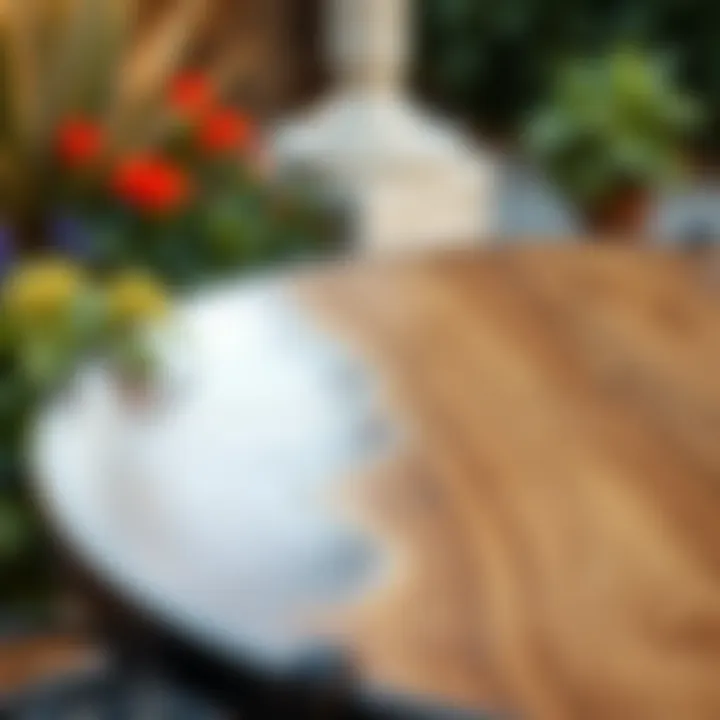
Intro
In recent years, outdoor living spaces have taken a significant leap from simple patios to vibrant extensions of our homes. With this transformation, the furniture choices we make have also evolved. A notable trend in this realm is the rise of metal patio tables crafted to resemble wood. These pieces not only capture the warm and inviting feel of timber but also infuse durability and low maintenance into outdoor aesthetics. This article aims to dissect this trend, offering insights about design inspirations, the benefits of materials, and how you can integrate these tables into your outdoor settings.
Furniture Design Trends
As we navigate through the world of outdoor furniture, it is essential to recognize the prevailing design trends, especially those that showcase the charm of natural elements. The following sections will shed light on how metal tables are breaking traditional barriers by mimicking wood.
Current Styles and Aesthetics
Metal patio tables designed to look like wood come in an impressive array of styles. From rustic farm table designs to sleek, modern lines, there is something for every taste. The key here is the ability of these tables to blend seamlessly with various outdoor themes.
- Rustic Charm: Tables that capture the textured grain and knots of wood, often featuring a distressed finish.
- Contemporary: Sleek, painted metal surfaces that offer a minimalist yet sophisticated vibe, aimed at enhancing modern outdoor decor.
- Industrial: Featuring raw metal and a rough finish, these tables bring an urban edge to any patio, complementing furniture pieces made of reclaimed wood.
Color Palettes and Materials
Color choices play a pivotal role in the overall aesthetic of a patio. Metal tables come in hues that mimic natural wood tones: deep browns, warm grays, and even bright whites can all be found in this furniture category. The finishing touches, such as weather-resistant powder coating, not only maintain appearances but also enhance longevity.
Often, textures are integrated into metal surfaces using advanced techniques, creating intricate patterns that feel authentic. This attention to detail ensures that even up close, these tables defy the perception of being merely metal furniture.
"Choosing the right style and color can transform a mundane patio into a personal sanctuary."
Buying Guides
When it comes to selecting a metal patio table that imitates wood, certain considerations can help you make the right choice.
Essential Considerations When Purchasing
- Durability: Ensure the metal used is rust-resistant, particularly if your patio experiences harsh weather conditions.
- Weight: Heavier tables provide stability against winds, while lighter ones may offer flexibility in rearranging your patio layout.
- Finish: Look for powder-coated options that resist scratches and fading, keeping the table looking new for longer.
- Size: Evaluate your space. A larger table works well for gatherings, but a compact design maximizes space efficiency.
Top Recommendations for Different Budgets
Here are some recommendations you might consider:
- Budget-Friendly: The Crosley Furniture Landon Outdoor Dining Table offers a faux-wood finish and sturdy build, all at a reasonable price.
- Mid-Range: The Keter Unity Portable Outdoor Table combines style with storage capabilities, featuring a sleek design that suits a smaller patio.
- High-End Choice: The Brown Jordan Modern Outdoor Dining Table is magnificent and incorporates premium materials and craftsmanship that elevate any garden or patio.
Preamble to Metal Patio Tables
In recent years, metal patio tables that mimic the look of wood have garnered significant attention among homeowners and design enthusiasts alike. This surge in popularity can be attributed to their ability to blend durability with aesthetic charm. As outdoor spaces increasingly serve as extensions of our living environments, the choice of furniture becomes more important than mere functionality. Metal tables designed to resemble wood present a unique solution, balancing style with practical benefits that cater to the evolving needs of outdoor living.
Defining the Concept
Metal patio tables that mimic wood utilize innovative manufacturing techniques to recreate the visual and tactile elements of natural wood while leveraging the inherent advantages of metal. With a diverse range of designs, these tables often employ finishes that replicate wood textures, achieving a realistic appearance that appeals to many consumers. Whether it's the rustic charm of reclaimed wood or the sleekness of contemporary design, metal options can fit right into various patio ambiances. A homeowner might choose these tables to ensure that their outdoor space remains stylish without compromising on practicality or durability.
These tables typically come in various styles, from classic to modern, allowing for easy integration into existing outdoor décor. Their resilient nature means they can endure harsh weather conditions without warping or fading as natural wood can.
The Growing Popularity
The rising trend in metal tables designed to mimic wood is not a mere fad; it reflects broader changes in consumer preferences and lifestyle choices. A significant driver of this change is the increasing awareness of sustainability and durability in furniture selection. Homeowners are looking for outdoor pieces that do not only enhance their aesthetic appeal but also promise long-lasting performance, minimizing the need for frequent replacements.
Moreover, as outdoor design practices continue to evolve, many are shifting towards more versatile and adaptable solutions. Metal tables offer that flexibility. Their lightweight nature makes them easier to rearrange, allowing for personalized outdoor layouts that can adapt to different events or moods.
"Choosing a metal patio table that resembles wood can transform your outdoor area, providing both beauty and practicality, which is hard to come by in traditional wood."
In summary, the combination of durability, ease of maintenance, and visual appeal has propelled metal patio tables to the forefront of outdoor furniture trends. For homeowners, this choice means creating inviting spaces that serve as a sanctuary for relaxation and gatherings, without overwhelming upkeep.
Design Characteristics
When it comes to metal patio tables designed to mimic wood, design characteristics play a pivotal role in combining aesthetic charm with functionality. This blend of qualities not only elevates outdoor settings but also addresses practical needs homeowners face. Here, we dive into the intricacies of visual appeal, texture and finish options, and color variations that these tables offer.
Visual Appeal
Metal tables that resemble wood bring forth a unique visual appeal that can transform any patio into a cozy yet modern outdoor space. Unlike traditional metal furniture, these tables often showcase intricate patterns and grain-like textures that create an inviting atmosphere. They are not just functional; they can be a real showpiece, catching the eye with their uncanny resemblance to natural wood.
Imagine stepping onto your patio where a table crafted from weather-resistant metal displays a finish that mirrors rustic oak. This visual connection to wood can elicit feelings of warmth and familiarity, perfect for family gatherings or intimate dinners.
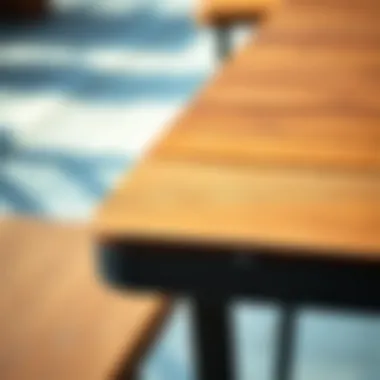
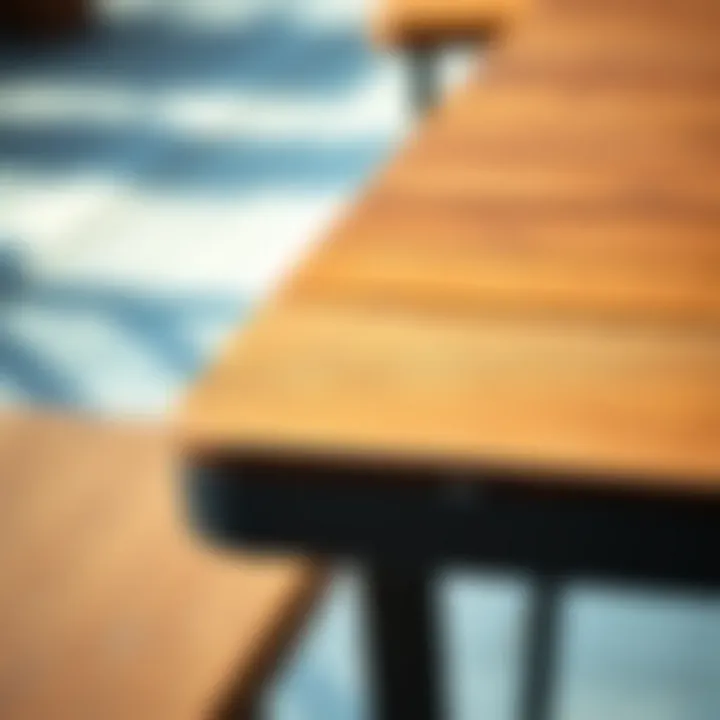
Texture and Finish Options
The texture and finish of these tables are essential when striving for that wood-like appearance. Manufacturers employ various techniques like powder coating and plating to achieve a range of textures that can either be smooth, rough, or somewhere in between. These finishes not only appeal to the senses but also enhance the table's durability.
- Powder Coated Finishes: Popular for their durability and variety, powder-coated tables can mimic the feel of unfinished wood while resisting scratches and corrosion.
- Textured Finishes: Tables with a textured surface often emulate the tactile feel of natural timber, providing an inviting touch that draws users in.
This range of finishes allows homeowners to select pieces that best fit their outdoor décor, effectively combining utility with aesthetics.
Color Variations
Another striking feature is color variation. Metal tables that mimic wood come in an array of hues, from deep browns emulating rich mahogany to lighter tones mimicking maple. This palette supports versatility in design, allowing the furniture to complement various custom motifs in outdoor spaces.
Choosing the right color can greatly impact the mood of an outdoor area. For instance, darker colors may create a sense of coziness, while lighter shades can open up the space, making it feel airy and welcoming.
In addition to standard colors, some brands offer customizable options, further enabling homeowners to tailor their selections to fit personal style preferences.
By focusing on these design characteristics, you can transform outdoor areas into stylish havens that are both visually appealing and practical, allowing you to enjoy the best of both worlds.
Materials and Construction
When it comes to metal patio tables designed to resemble wood, understanding the underpinning materials and construction is essential. This section provides insights into how the type of metals used, their durability, and weight considerations profoundly influence both aesthetic appeal and practicality. Metal offers a unique blend of beauty and resilience, making it a captivating choice for outdoor furniture that needs to withstand the elements.
Types of Metal Used
Various types of metals are employed in creating these innovative patio tables, each with its own set of properties. Common choices include:
- Aluminum: Lightweight and highly resistant to rust, aluminum is frequently used. It's easy to move around your patio but still offers a robust feel. Moreover, aluminum can be coated with finishes that mimic wood grain without losing its metallic properties.
- Steel: Known for its strength, steel tables can handle heavy use. However, they can be prone to rust if not properly coated. Powder-coated steel exudes durability and can be found in a variety of colors and textures that emulate wood.
- Stainless Steel: This variant combines both aesthetic and functional benefits, being resistant to corrosion while also offering an upscale look. Stainless steel patio tables are often sleek and elegant, blending seamlessly with various garden themes.
Ultimately, the choice of metal affects not only the table's appearance but its longevity and maintenance needs. Homeowners should carefully consider these factors when selecting a metal patio table.
Durability Factors
Durability is one of the primary considerations when it comes to patio furniture. Here are some factors that ensure the resilience of metal tables:
- Finish Quality: The coating finish on metal tables plays a pivotal role in their performance. High-quality powder coating not only provides a protective barrier against rust and weather but also enhances the table's look, mimicking the textures of natural wood.
- Corrosion Resistance: Tables made from aluminum or stainless steel are oftentimes favored due to their inherent resistance to rust. On the flip side, if purchasing steel tables, inquire about the protective coatings.
- Weatherability: Metal tables should be good withstanders of UV rays, rain, and moisture. Be sure to look for tables specifically designed for outdoor use, as they meet specific performance metrics that ensure they hold up over time.
"The right materials not only beautify your patio; they ensure your investment is protected against the elements."
Weight Considerations
Weight is another aspect that affects both functionality and stability. Heavier tables tend to resist wind better, making them ideal for breezy locations. Lighter materials such as aluminum can be convenient for those who enjoy rearranging their outdoor space frequently, despite being more susceptible to being blown around during windy days. Here are some pointers:
- Stability: Tables with a heavier frame don't just stay put; they also tend to feel more solid and durable when in use. This stability is particularly important for dining setups.
- Mobility: For those who love to change their outdoor layout, a lighter table can be easier to reposition, making it great for impromptu gatherings or shifting the setup for optimal sun exposure.
- Surface Area vs. Weight Ratio: Consider how size affects weight. A larger table may be heavier, needing a solid surface underneath, while a smaller table could provide good mobility with some emphasis on sturdiness.
Advantages Over Traditional Wood
Metal patio tables designed to mimic wood offer homeowners several significant advantages over traditional wooden furniture. These benefits extend beyond mere aesthetics, reflecting a growing trend towards practical yet stylish outdoor living solutions. The key elements to consider include weather resistance, maintenance requirements, and lifespan comparison, all of which position metal options as a smart investment.
Weather Resistance
One of the primary advantages of metal patio tables is their exceptional weather resistance. Unlike traditional wood, which can warp, crack, or rot when exposed to the elements, metals such as aluminum and steel are inherently resilient. For instance, aluminum's lightweight nature enables it to withstand high winds with little chance of damage. Moreover, many metal tables come with powder-coated finishes, which add an extra layer of protection against rust and corrosion.
- Aluminum: Resists rust and is often treated to withstand moisture.
- Steel: Though heavier, treated steel can also endure various weather patterns, given proper care.
Homeowners can breathe easier knowing their furniture won't fall victim to sudden rainstorms or intense sunlight. In fact, many find that an occasional wipe down is all it takes to keep these tables looking sharp, even in unpredictable weather.
"Metal patio tables fuse durability with style, making them a popular choice for those who refuse to compromise on quality."
Maintenance Requirements
When it comes to maintenance, metal patio tables also outshine their wooden counterparts. Wooden tables often require periodic sealing or staining to maintain their appearance and combat the effects of moisture. In contrast, metal tables are usually far simpler to maintain. Wiping down with a damp cloth usually suffices to keep the surface clean.
- No Staining: Unlike wood, there's no need for regular re-staining or sealing.
- Simple Cleaning: A mixture of soap and water is often all that's needed to keep the table looking pristine. If tougher stains occur, mild abrasives can be used without fear of damaging the surface.
This reduced maintenance means more time enjoying gatherings with friends and family and less time worrying about preserving the furniture's integrity.
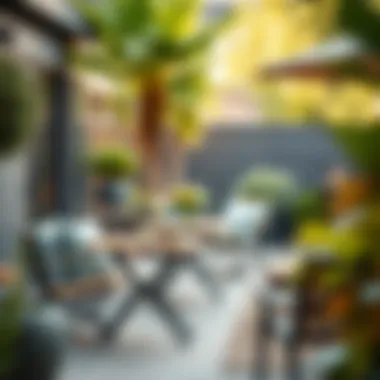
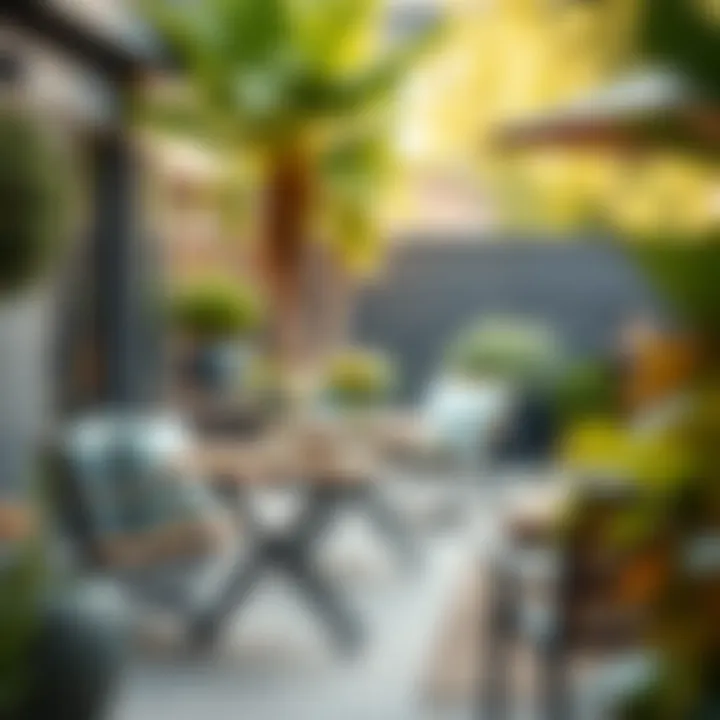
Lifespan Comparison
In terms of longevity, metal patio tables often have a distinct advantage over traditional wood. While a well-cared-for wooden table may last 10 to 15 years, metal tables can easily exceed this lifespan—often lasting 20 years or more, depending on the materials used and the maintenance provided.
Key factors affecting longevity include:
- Material Quality: Choosing high-grade metals can significantly enhance durability.
- Environment: Tables located in harsh environments may require more care, though metal generally performs better than wood.
Households are increasingly recognizing that investing in metal patio tables may ultimately result in lower replacement costs. When considering long-term value, longevity combined with low upkeep makes metal options a compelling choice.
Integration with Outdoor Spaces
When it comes to creating a welcoming atmosphere outdoors, the selection of furniture plays an important role. Metal patio tables that mimic wood are not just functional; they are a keystone in enhancing the overall aesthetic of outdoor spaces. In this section, we’ll discuss how these tables can fit seamlessly into various outdoor environments, ensuring that style and practicality go hand in hand.
Complementing Various écor Styles
One of the standout features of these metal tables is their ability to harmonize with an array of decor styles. Whether your backyard features a rustic farmhouse vibe or a sleek modern design, there’s likely a metal patio table that can elevate that space. For instance, tables that have a distressed finish can effortlessly complement a laid-back, country feel, while those with a polished appearance can make a contemporary patio shine.
- Rustic: Opt for a table with a wood-like grain finish to give your outdoor area a warm and inviting feel, reminiscent of natural wood without the ongoing maintenance.
- Modern: A sleek, geometrically designed table can provide an edgy contrast to lush greenery, making it a focal point that attracts attention while serving its purpose.
- Eclectic: Mix and match various styles, using a distinctive metal table as a statement piece among more traditional seating.
Furthermore, the versatility of color in these tables allows homeowners to choose pieces that either stand out or blend into the surrounding scenery. Rich earthy tones can evoke a natural ambiance, while vibrant shades can bring energy and life to the patio.
Optimizing Space Utilization
In outdoor design, efficient use of space is paramount. Metal patio tables mimicking wood provide solutions to several space-oriented challenges. Unlike solid wood, which can be cumbersome, many metal alternatives are lightweight and movable, allowing for flexibility in arranging outdoor layouts.
Some practical aspects to consider include:
- Compact Designs: Round tables often serve as great space savers, promoting intimacy while occupying less area.
- Multi-functional Pieces: Many modern metal tables also offer storage capabilities, making them not only stylish but also practical. They can double as a storage box for cushions or gardening tools when not in use.
- Height Variability: Consider tables with adjustable heights that can transition from dining to coffee table configurations. This adaptability is essential in small yards or balconies where every inch counts.
By thoughtfully integrating metal patio tables into your outdoor space, you can create a functional yet stylish environment that caters to both relaxation and entertainment. The essence lies in not only selecting a table that fits your aesthetic but also in choosing one that accommodates your lifestyle.
"A well-decorated outdoor area can mirror inner home aesthetics, creating a seamless extension of living space that invites connection with nature."
Environmental Considerations
In today's world, the harmony between aesthetics and environmental responsibility has become a crucial topic. Homeowners and designers alike are increasingly taking note of how materials and manufacturing choices can impact the environment. When it comes to patio furniture, particularly those crafted from metal but designed to mimic wood, several environmental considerations come into play. Understanding these aspects not only aids in making wise purchases but also fosters an overall commitment to sustainability.
Sustainability of Materials
When we talk about sustainability, we refer to the practice of creating products that minimize environmental impact. Metal patio tables that resemble wood are typically made from recyclable materials, such as aluminum or steel. Using recycled metals not only conserves energy but also reduces the demand for new raw materials.
- Aluminum is lightweight, resistant to corrosion, and can be indefinitely recycled without losing quality. It makes for a versatile choice in outdoor furniture.
- Steel, while heavier, brings robustness that stands the test of time. When sourced responsibly, it can also be part of a sustainable lifecycle.
An increasing number of manufacturers are paying more attention to sustainability by using eco-friendly finishes and treatments instead of harmful chemicals. Eco-conscious companies are leading the way, giving consumers the chance to support green initiatives through their purchases.
Recycling and Reusability
The choice of materials extends beyond initial production; it also encompasses the end of life. Recyclability plays a significant role in a product’s overall sustainability. Metal patio tables designed to mimic wood can often be fully recycled at the end of their lifespan, unlike conventional wooden tables which may end up in a landfill.
- Reusability is another critical aspect. Metal tables can be refurbished or repurposed with relative ease. For instance, older designs can be updated with new coatings to revive their appearance, giving them a new lease on life without requiring brand new raw materials.
The ability to recycle and reuse creates a circular economy where materials don’t simply become waste. Instead, they are transformed and reintroduced into the production cycle. This not only conserves resources but also minimizes ecological footprints.
Consider investing in metal patio tables that embody sustainability—both in design and in material lifecycle. It’s an investment in a greener future.
As the trend of metal patio furniture continues to grow, so does the importance of making informed choices that prioritize environmental well-being. Every small step in selecting sustainable products contributes to a healthier planet, turning the great outdoors into a space that reflects both style and responsibility.
Care and Maintenance Tips
Caring for metal patio tables that mimic wood is essential to keep them looking their best while ensuring longevity. These tables are designed to bring an aesthetic that captures the warmth of wood, yet they require a unique maintenance approach that reflects their metal composition. Proper care not only enhances their durability but can also amplify their visual appeal in outdoor spaces.
Cleaning Procedures
Cleaning these tables might seem straightforward, but there are nuances that help retain their charm. To effectively clean metal patio tables, begin with gentle soap mixed with warm water. A soft cloth or a sponge can work wonders here; avoid using abrasive materials that might scratch the surface. Wipe down all surfaces, including any nooks and crannies where dirt might accumulate. Furthermore, any bird droppings or sticky substances should be addressed promptly, as organic material can break down the protective coatings designed to shield the metal from rust and corrosion.
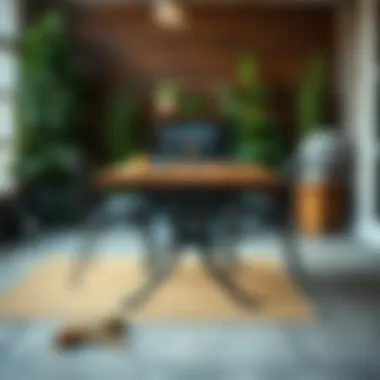
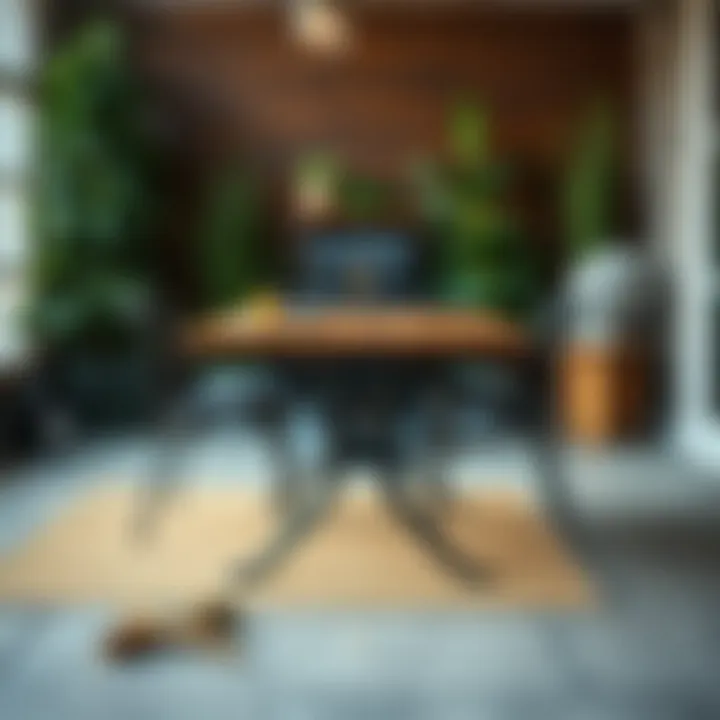
Tip: For stubborn stains, a mixture of baking soda and water can create a paste that you can apply to the affected area. Let it sit for a bit before rinsing off.
Once cleaned, it's wise to rinse the table thoroughly and dry it immediately to prevent water spots or potential rust. Regular cleaning will prevent dirt buildup and allow your tables to shine brightly through outdoor gatherings.
Storage Recommendations
When it comes to storage, metal patio tables possess a different set of requirements than traditional wooden furniture. If you live in an area with harsh winters or unpredictable weather, consider storing your furniture indoors during off-seasons. This protection can drastically extend the life of your patio table.
Even during the typical outdoor seasons, use a cover designed specifically for metal furniture. A well-fitted cover can guard against dust, debris, and even UV rays that may fade the finish over time. If no cover is available, place the table in a shaded area to reduce its exposure to direct sunlight.
Additionally, if you must leave the table outside, try to elevate it off the ground slightly, perhaps by placing it on pavers rather than directly on the grass or soil. Doing so can help prevent moisture buildup that leads to rust over time.
In summary, maintaining metal patio tables that emulate wood takes a bit of work, but the reward is worth it. By incorporating proper cleaning procedures and thoughtful storage strategies, you'll ensure your outdoor furniture retains its beauty and function for years to come.
Market Trends and Innovations
The landscape of outdoor furniture is always shifting, especially when it comes to metal patio tables that simulate the allure of wood. Understanding market trends and innovations in this field is more important than ever for homeowners and design enthusiasts alike. With preferences changing and sustainability taking center stage, many are looking for practical yet stylish solutions for their outdoor spaces. This section delves into the latest market trajectories and the cutting-edge innovations that are setting the bar high for outdoor living.
Emerging Designs
As the outdoor design realm evolves, emerging designs in metal patio tables designed to mimic wood are capturing significant attention. Styles range from the rustic to the modern, offering a variety of aesthetic choices that blend seamlessly with different outdoor environments. Some popular trends include:
- Geometric Patterns: Tables with clean, geometric lines appeal to a minimalist design sensibility. They serve as striking centerpieces that can complement other furnishings.
- Mixed Materials: Utilizing a combination of metal and other materials, like glass or stone, can elevate the overall look. For instance, a metal frame paired with a ceramic table top adds both elegance and durability.
- Artisanal Finishes: Handcrafted designs with textured finishes are becoming sought after. These tables feature unique detailing that imitates the imperfections found in natural wood, appealing to those seeking authenticity in their outdoor decor.
By tapping into these emerging designs, manufacturers are not just selling furniture—they're creating statements. This approach allows homeowners to express individuality while enjoying the practical advantages of metal.
Technological Advancements
Technological advancements have drastically transformed the way metal patio tables are produced and function. Innovations are making these pieces more appealing, durable, and user-friendly. Here are some noteworthy advancements:
- Advanced Coating Techniques: Utilizing powder-coating technology enhances resistance to scratching and fading. This ensures that furniture maintains its stylish appearance even after enduring various weather elements.
- Smart Features: Some contemporary designs incorporate smart features, like built-in wireless charging pads or LED under-lighting, thereby integrating modern technology into outdoor leisure. This adds convenience and elegance.
- Eco-friendly Manufacturing: Many brands are adopting eco-friendly production methods. Using recycled materials and less harmful chemicals in finishes not only reduces environmental impact but also appeals to conscientious consumers.
Incorporating these technological advancements speaks volumes about a brand's commitment to quality and sustainability. As consumers become more mindful of their purchases, opting for products that reflect these values will resonate well.
"Investing in well-designed, sustainable metal patio tables is not just a choice; it's a statement of style and environmental responsibility."
Consumer Considerations
Understanding consumer considerations is crucial when it comes to choosing metal patio tables that mimic wood. From budgeting to warranties, these factors can significantly influence the purchase decisions of homeowners, designers, and DIY enthusiasts alike. For many, outdoor furniture not only serves a practical purpose but also contributes to the aesthetic and functionality of an outdoor space. Hence, making well-informed choices leads to longer-lasting satisfaction with your investment.
Budgeting for Quality
When budgeting for a metal patio table, quality over quantity should be the ethos guiding your decisions. While it can be tempting to opt for the cheapest option available, it’s essential to recognize that the price often reflects quality, craftsmanship, and longevity. Metal patio tables that impersonate wood come in various price ranges, and striking that balance between what you can afford and what you need offers a more rewarding outcome.
- Evaluate Material Quality: Check whether the table is made from aluminum, steel, or an alloy, as this will affect its durability. Often, aluminum is lighter and rust-resistant but may lack the weight of steel, which provides stability against wind.
- Analyze Design Features: Ingenious designs, such as powder coating that gives a wooden texture or unique paint finishes, may cost a bit more, but they can significantly enhance the table's visual appeal and durability over time.
- Consider Long-Term Investment: Picture your outdoor space a few years down the line. Higher quality tables may have a higher upfront cost but often save money in the long run due to reduced maintenance and replacement costs. Think of it as an investment in your home’s overall livability.
Warranties and Customer Service
Warranties and customer support play a pivotal role in consumer decisions, especially for products designed to withstand the elements. Investing in a metal patio table is not just about the piece itself, but also about the support structure that surrounds your purchase. A good warranty can offer peace of mind, ensuring that you're not left in the lurch should something go awry.
- Look for Comprehensive Warranties: A reputable manufacturer often provides warranties that cover significant flaws and damages. A table may have a warranty lasting several years, signaling that the company has confidence in its product quality.
- Assess Customer Service Responsiveness: Before purchasing, research the brand’s reputation for customer service. Websites like reddit.com or specialized forums might have valuable consumer insights. If potential issues arise, good customer service can transform an unpleasant scenario into an amicable solution.
In short, warranties not only protect your investment but can also enhance the buying experience should you need assistance.
Adopting a meticulous approach to budgeting and evaluating warranties ensures that your investment in a metal patio table yielding the aesthetic sensibilities of wood meets the practical needs of your outdoor living space. When each decision is well thought out, it adds to your comfort and enhances the enjoyment of those lovely summer evenings outside.
Epilogue
As we draw the curtain on our exploration of metal patio tables designed to mimic wood, it’s essential to underscore the nuanced dialogue between style and practicality this furniture embodies. This article illuminated how these tables not only adapt the visual charm of wooden designs but also offer a whole suite of benefits that are hard to ignore in today's fast-paced, eco-conscious society.
Summarizing Key Insights
- Durability Meets Aesthetics: One glaring takeaway is the combination of sturdiness and beauty. Metal patio tables, with their tough finishes and design versatility, can withstand the ravages of weather while still showcasing the warm, inviting look of natural wood.
- Low Maintenance: A critical insight for homeowners is the reduced maintenance requirement. Unlike traditional wood, which demands regular sealing and staining, metal options simply need a thorough cleaning now and then to keep them looking sharp.
- Environmental Benefits: The sustainability discussion also deserves mention. Many manufacturers are now recycling metals in the production process, significantly lessening their ecological footprint. This means opting for metal can be a responsible choice.
- Versatility In Design: From contemporary sleek lines to rustic charm, these tables cater to a wide array of design preferences and can easily complement various outdoor spaces, offering endless possibilities when it comes to styling a patio, garden, or balcony.
A well-chosen metal table can tie your outdoor decor together seamlessly, providing both function and flair.
Future of Metal Patio Tables
Looking ahead, the trajectory of metal patio tables that mimic wood appears bright and promising. Several trends signal that their market presence will only grow stronger:
- Innovative Materials: The future may well see advancements in alloy technology, providing even lighter yet more robust options. This leap forward can change how we perceive metal—making it appear even more like wood while enhancing durability.
- Smart Designs: Imagine patio tables that incorporate integrated charging stations or sensor technology that can assess outdoor conditions. These smart components could bring convenience to outdoor dining and lounging, creating a seamless blend of technology with traditional aesthetics.
- Customization Options: The trend towards personalized outdoor furniture is gaining traction. Expect to see more brands offering bespoke options allowing for color choices and textures that match individual tastes.
- Broader Sustainability Practices: As the collective consciousness about environmental impact continues to rise, the industry will likely keep adapting. Expect more brands to focus on sustainable practices at every production stage—whether it’s sourcing, manufacturing, or recycling.
In summary, the evolution of metal patio tables suggests a significant shift in outdoor living spaces. These tables balance style with resilience, offering home and design enthusiasts a smart and stylish option for their outdoor areas. The future holds exciting possibilities that marry aesthetic desires with modern technology and sustainability.







